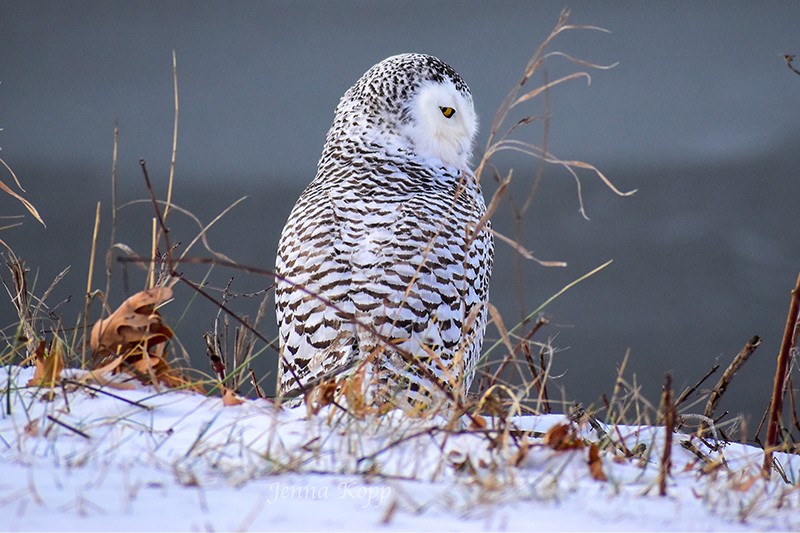
JENNA KOPP
Snowy owls (like this one photographed in Michigan) make rare trips south in search of food.
A snowy owl showing signs of distress has become a subject of concern for local wildlife organizations in the St. Louis region.
On December 1, a team of naturalists from the World Bird Sanctuary attempted to capture the owl, which has likely traveled thousands of miles from its native Arctic home in search of food. CJ White, a naturalist with the sanctuary, tells RFT that the bird of prey is in danger of being "harassed to exhaustion."
"It was something that we had to, we had to step in," White says of the rescue attempt, which failed when the owl flew over a body of water. White says he saw numerous bystanders at the scene, including photographers, who have been trailing the owl for days.
The problem is that these owls are far from home. As White explains, the owls making the trip tend to be young and searching for food amid a shortage of their usual diet of lemmings. It may also be that these recently matured owls are being forced to range outside the massive territories of their parents, flying further and further south in search of their own hunting grounds.
By the time the owls make it to St. Louis, they are on their last reserves of energy, and they may only have the strength for a few hunting attempts before they're too slow and harried to close in on a mouse or other small rodents. By then, it's too late, and the snowy owls simply starve.
White says he wants the public to recognize that they are pursuing an animal that needs its space to hunt to survive. The people trampling into its path may believe they're just taking a photo of the ruffled "Hedwig" from the Harry Potter films, but they may be also contributing to its death.
"Whenever people are taking pictures from, say, a football field away, 300 feet, they might think that 'Oh, I just got this great picture,' but if they're parking their car and they're getting out and they're walking around through grasses to try to get a few angles, then the mice and the smaller prey that this animal has been surviving off of is not going to be there," he says.
Similar disruptive reactions to the presence of snowy owls have played out over the last decade, White says. He suggests the situation has become worse in the last two or three years, as social media has made it easier for the public to share and track the snowy owls' rare appearances in St. Louis.
White says he's known of multiple snowy owls that were essentially pursued to death by photographers around St. Louis. While the sanctuary has managed to capture some snowy owls in distress, in other cases the animals are too far gone for medical care. White now fears for the handful of other snowy owls that have been spotted in the region in the last week; he also notes that staging rescue missions have been made more difficult by the competing presence of sightseers and photographers.
The presence of the snowy owl — and its human followers — was also acknowledged in a December 1 Facebook post by the Audubon Center at Riverlands in St. Charles.
"As birds, such as this young female snowy owl, seek refuge and refueling at Riverlands or elsewhere, we ask that everyone follow basic but very important etiquette when viewing or photographing wildlife," the center said in its post, which included a link to the organization's guide to ethical bird photography.
On Thursday, the center posted an example of an ethically-captured photo of the snowy owl, writing that its visit has caused "quite a stir and sparked a number of amazing photos."
Indeed, several local photographers have posted shots of the same snowy owl on Facebook. While some of this attention has been disruptive, White stresses that he's not attacking all wildlife photographers. He says that it takes a level of consideration — and the right equipment, including telephoto lenses — to ensure photographers don't become part of a potentially fatal owl paparazzi.
"We have to find that middle ground," he says. "The animal still has to be able to hunt, and you can take your pictures. You can see them by using binoculars, spotting scopes, cameras with longer lenses — But if we're interfering with that animal, then they're not going to be able to continue."
The World Bird Sanctuary is asking the public to contact the center (636-225-4390) or other state wildlife organizations if they see a snowy owl showing signs of distress. Evidence that something is wrong includes the owl spending extended time on the ground or having iced-over feet.
In a January PSA, the sanctuary's executive director Dawn Griffard said that the public needs to give the owls space. "They're very hungry when they get here," she said, "they're a little bit emaciated, and if they hunt and don't find food right away, then it just gets worse from there."
Follow Danny Wicentowski on Twitter at @D_Towski. E-mail the author at [email protected]





